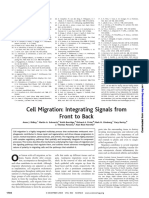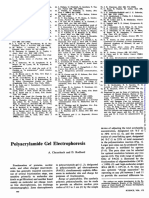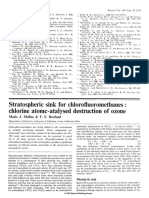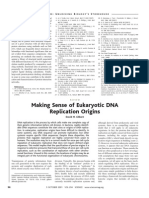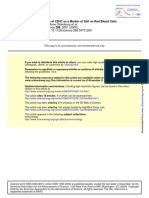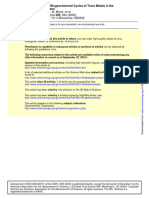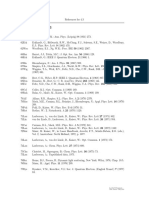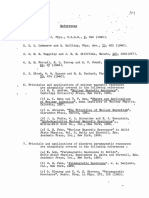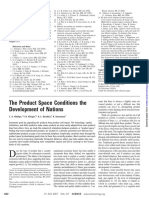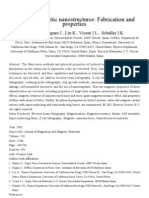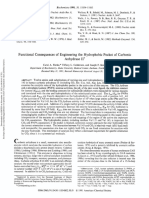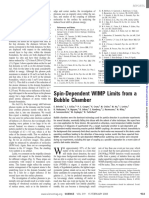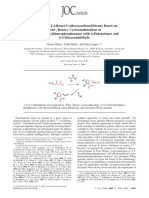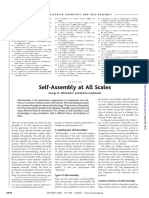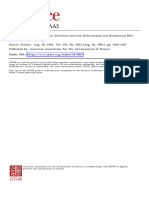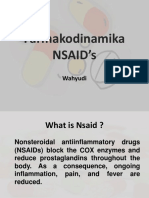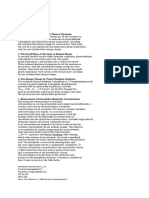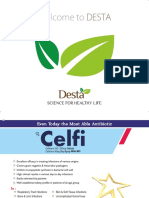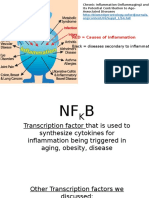Song 1996
Song 1996
Uploaded by
Iuliana SoldanescuCopyright:
Available Formats
Song 1996
Song 1996
Uploaded by
Iuliana SoldanescuOriginal Description:
Copyright
Available Formats
Share this document
Did you find this document useful?
Is this content inappropriate?
Copyright:
Available Formats
Song 1996
Song 1996
Uploaded by
Iuliana SoldanescuCopyright:
Available Formats
L. M. Obed, J. Biol. Chem. 270, 30701 (1995). Biol. 56, 533 (1994); S. Schutze eta/.
94); S. Schutze eta/., Cell 71, 765 (1993); B. Law and S. Rossie, ibid. 270, 12808
10. K. A. Dresser, S. Mathias, R. N. Kolesnick, Science (1992). (1995); R. T. Dobrowsky and Y. A. Hannun, Adv.
255, 1715 (1992); A. Haimovtz-Friedman et a/. , J. 32. G. Dbaibo, L. M. Obed, Y. A. Hannun,J. Bioi. Chem. Lipid Res. 25, 91 (1993).
Exp. Med. 180, 525 (1994); M. G. Cfone eta/. , ibid., 268, 17762 (1993); J. C. Betts, A. B. Agranoff, G. J. 43. J. T. Nickels and J. R. Broach, Genes Dev. 10, 382
p. 1547; S. Mathias eta/., Science 259, 519 (1993). Nabel, J. A. Shayman, ibid. 269, 8455 (1994). (1996).
11. M.-Y. Kim, C. L~nardic,L. Obeid, Y. Hannun, J. Biol. 33. Z. Yang, M. Costanzo, D. W. Gode, R. N. Koesnck, 44. J. D. Fishbe~n,R. T. Dobrowsky, A. Bielawska, S.
Chem. 266, 484 (1991); N. Andrieu, R. Salvayre, T. ibid. 268, 20520 (1993); S. A. G. Reddy et a/., ibid. Garrett, Y. A. Hannun, J. Biol. Chem. 268, 9255
Levade, Biochem. J. 303, 341 (1994); C. G. Tepper 269, 25369 (1994). (1993).
eta/., Proc. Nati. Acad. Sci. U.S.A. 92, 8443 (1995). 34. J.-P. Jaffrezou et a/., Biochim. Biophys. Acta Mol. 45. G. Muleretai., EMBO J. 14, 1961 (1995);J. Lozano
12. E. R. Smth and A. H. MerrI Jr., J. Biol. Chem. 270, CeIlRes. 1266, 1 (1995); M. Higuchi, S. S~ngh,J. -P. eta/. , J. Bioi. Chem. 269, 19200 (1994).
18749 (1995). Jaffrezou, B. B. Aggarwal, J. /mmuno/. 157, 297 46. C. K. Joseph, H.-S. Byun, R. B~ttman,R. N. Kole-
13. L. R. Balou, C. P. Chao, M. A. Holness, S. C. Barker, (1996). snick, J. Bioi. Chem. 268, 20002 (1993);S. Mathas,
R. Raghow, ibid. 267,20044 (1992); J. Q. Chen, M. 35. K. Kuno, K. Sukegawa, Y. Ishikawa, T. Ori, K. Mat- K. A. Dresser, R. N. Koesnck, Proc. Natl. Acad. Sci.
Nikolova-Karakashian,A. H. Merril Jr., E. T. Morgan, sushima, int immunol. 6, 1269 (1994). U.S.A. 88, 10009 (1991).
ibid. 270, 25233 (1995); F. Yanaga and S. P. 36. R. E. Pagano, M. A. Sepansk, 0. C. Martin, J. Ceii 47. M. Faucher, N. Girones, Y. A. Hannun, R. M. Bell, R.
Watson, Biochem. J. 298, 733 (1994);T. Okazaki, R. Bioi. 109, 2067 (1989); A. G. Rosenwald and R. E. Davis, J. Bioi Chem. 263, 531 9 (1988); T. Goldkorn
M. Bell, Y. A. Hannun, J. Bioi. Chem. 264, 19076 Pagano, J. Bioi. Chem. 268, 4577 (1993); F. J. Field, eta/. , bid. 266, 16092 (1991).
(1989); T. Okazaki, A. B~elawska,R. M. Bell, Y. A. H. Chen, E. Born, B. Dixon, S. Mathur, J. Ciin, Invest. 48. J. LIU,S. Mathias, Z. Yang, R. N. Kolesnick, ibid.
Hannun,&id. 265, 15823 (1990); R. T. Dobrowsky, 92, 2609 (1993); C. M. Linardic, S. Jayadev, Y. A. 269, 3047 (1994).
M. H. ~ e r n e r A.
, M. Castelno, M. V. Chao, Y. A. Hannun, J. Bioi. Chem. 267, 14909 (1992); T. Oda, 49. T. Okazak, A. B~elawska,N. Domae, R. M. Bell, Y. A.
Hannun, Science 265, 1596 (1994); R. T. Do- C.-H. Chen, H. C. Wu, ibid. 270, 4088 (1995); C. M. Hannun, ibid,, p. 4070; M. W. Spence, Adv, Lipid
browsky, G. M. Jenkins, Y. A. Hannun, J. Biol. Linardic, S. Jayadev, Y. A. Hannun, Cell Growth Dif- Res. 26, 3 (1993); S. Chatterjee, ibid., p. 25.
Chem. 270,22135 (1995). fer. 7, 765 (1996). 50. S. Jayadev, C. M. Linardic, Y. A. Hannun, J. Bioi.
14. S. Jayadev et a/. , J. Biol. Chem. 270,2047 (1995); G. 37. L. Riboni, A. Prinetti, R. Bassi, A. Carniniti, G. Tetta- Chem. 269, 5757 (1994).
S. Dbaibo eta/., unpublished observations. mant, J. Biol. Chem. 270, 26868 (1995). 51. J. W. Larrick and S. C. Wright, FASEB J. 4, 3215
15. C. M. Linardcand Y. A. Hannun, J. Bioi, Chem. 269, 38. M. Hayakawa, S. Jayadev, M. Tsujmoto, Y. A. Han- (1990); M. Hayakawa et ai., J. Bioi. Chem. 268,
23530 (1994); N. Andr~eu,R. Salvayre, T. Levade, nun. F. Ito. Biochem. Bioohvs. Res. Commun. 220. 11290 11993).
Eur J. Biochem. 236, 738 (1996). 681 (1996);Y. Chang, be, be, J, A. Shayman, Proc. 52. G. J. ~ i o n kK.
. Rarner. P. Arnir. L. T. W~lliarns.
, Sci-
-
16. P. S. Liu and R. G. W. Anderson, J. Biol. Chem. 270, Natl. Acad. Sci. U.S.A. 92, 12275 (1995). ence 271, 808 (1996).'
271 79 (1995). 39. N. D. Ridgway, Biochim. Biophys. Acta Lipids L b i d 53. A. Kaen, R. A. Borchardt, R. M. Bell, Biochim. Bio-
17. A. Bielawska, C. M. Linardic, Y. A. Hannun, FEES Metab. 1256, 39 (1995); P. Santana et ai. , Endocri- phys. Acta Lipids Lipid Metab. 1125, 90 (1992); R.
Lett. 307, 21 1 (1992); L. M. Obed, C. M. Linardic, L. nology 136, 2345 (1995). Bose et ai. , Cell 82, 405 (1995).
A. Karolak, Y. A. Hannun, Science 259,1769 (1993); 40. J. C. Strum, K. I. Swenson, J. E.Turner, R. M. Bell, 54. J.-P. Jaffrezou eta/., EMBO J. 15, 241 7 (1996).
J. Biol. Chem. 270, 13541 (1995). 55. G. Dba~bo,M. Pushkareva, N. Alter, M. Smyth, L.
W. D. Jarvs eta/., Proc. Natl. Acad. Sci. U.S.A. 91,
73 (1994). , 41. S. J. F. Laulederkind,A. Bielawska, R. Raghow, Y.A.
Hannun, L. R. Balou, J. Exp. Med. 182, 599 (1995). 56.
Obeid, Y. Hannun, unpublished observations.
Supported by NIH (grant GM43825), the U.S. De-
18. A. B~elawska,H. M. Crane, D. Liotta, L. M. Obeid, Y.
42. R. T. Dobrowsky and Y. A. Hannun, J. Biol. Chem. partment of Defense (DAMD17-94J4301), and the
A. Hannun, J. Biol. Chem. 268, 26226 (1993).
267,5048 (1992);R. T. Dobrowsky, C. Kambayashi, Amercan Cancer Society (CB122). I thank L. Obeid
19. L. Rboni, R. Bassi, S. Sonnno, G. Tettamanti, FEBS for a careful and critical review of the manuscript.
M. C. Mumby, Y. A. Hannun, ibid. 268, 15523
Lett. 300, 188 (1992); A. H. Merril Jr. et ai. , J. Bioi.
Chem. 261, 12610 (1986); A. H. Merrill Jr. and E.
Wang, Methods Enzymoi. 209, 427 (1992); W. D.
Jarv~s,A. J. Turner, L. F. Pov~rk,R. S. Traylor, S.
Grant, CancerRes. 54, 1707 (I 994); C. S. S. Rani et
a/., J. Biol. Chem. 270, 2859 (1995);A. Bielawska et
RESEARCH AARTICL
a/., ibid. 271, 12646 (1996).
20. A. Gomez-Muiioz, D. W. Waggoner, L. O'Brien, D.
N. Brindey, J. Bioi. Chem. 270, 26318 (1995); G.
Dbaibo et ai. , Proc. Natl. Acad. Sci. U.S.A. 92, 1347
(1995).
Structure of Staphylococcal
21. R. A. Wolff, R. T. Dobrowsky, A. Bielawska, L. M.
Obeid, Y. A. Hannun, J. Biol. Chem. 269, 19605
(1994).
a-Hemolysin, a Heptameric
22. A. Gomez-Muiioz, A. Martin, L. O'Bren, D. N. Brind-
ley, ibid., p. 8937; T. Nakamura et ai. , ibid., p. 18384;
M. E. Venable, G. C. Blobe, L. M. Obeid, ibid., p.
Transmembrane Pore
26040; Z. Kiss and E. Deli, FEES Lett 365, 146
(1995);M. J. Jones and A. W. Murray, J. Bioi. Chem. Langzhou Song," Michael R. Hobaugh," Christopher Shustak,
270. 5007 11995): Y. Nakarnura et ai.. J. immunoi. Stephen Cheley, Hagan Bayley, J. Eric Gouauxt
156, 256 ( i 9 9 6 ) : ' ~ .Wong, X.-B. Li, N. Hunchuk,
J. Biol. Chem. 270, 3056 (1995).
23. J. Quintans, J. Kilkus, C. L. McShan, A. R. The structure of the Staphylococcus aureus a-hemolysin pore has been determined to
Gottschalk, G. Dawson, Biochem. Biophys. Res. 1.9 b, resolution. Contained within the mushroom-shaped homo-oligomeric heptamer is
Commun. 202, 710 (1994); M. Chen eta/., Cancer
Res. 55, 991 (1995); S. J. Martin eta/., EMBO J. 14,
a solvent-filled channel, 100 b, in length, that runs along the sevenfold axis and ranges
51 91 (1995); H. Sawai et ai., J. Bioi. Chem. 270, from 14 b, to 46 b, in diameter. The lytic, transmembrane domain comprises the lower
27326 (1995); B. Brugg, P. P. M~che,Y. Agid, M. half of a 14-strand antiparallel p barrel, to which each protomer contributes two p strands,
Ruberg, J. Neurochem. 66, 733 (1996). each 65 b, long. The interior of the p barrel is primarily hydrophilic, and the exterior has
24. M. J. Smyth et ai., Biochem. J. 316, 25 (1996); S. J.
Martn et a/., J. Bioi. Chem. 270, 6425 (1995). a hydrophobic belt 28 b, wide. The structure proves the heptameric subunit stoichiometry
25. J. Zhang et a/., Proc. Nati. Acad. Sci. U.S.A. 93, of the a-hemolysin oligomer, shows that a glycine-rich and solvent-exposed region of
5325 (1996). a water-soluble protein can self-assemble to form a transmembrane pore of defined
26. S. J. Martin eta/. , Cell Death Differ 2, 253 (1995).
27. A. Ito and K. Horigorne, J. Neurochem. 65, 463
structure, and provides insight into the principles of membrane interaction and transport
(1995); Y. Goodman and M. P. Mattson, ibid. 66, activity of p barrel pore-forming toxins.
869 (1996).
28. M. A. Raines, R. N. Koesnck, D. W. Gode, J. Bioi.
Chem. 268, 14572 (1993).
29. J. K. Westwick, A. E. Bielawska, G. Dbaibo, Y. A.
Hannun, D. A. Brenner, ibid. 270, 22689 (1995); S. T h e a-hemolysin (aHL)of the human cytes, and endothelial cells (1). Membrane-
Pyne, J. Chapman, L. Steee, N. J. Pyne, Eur. J. Bio- pathogen Staphylococcus aureus is secreted bound monomers assemble to form 232.4-
chem. 237, 81 9 (1996); K. M. Latinis and G. A. Ko-
retzky, Biood 87, 871 (1996).
as a 33.2-kD water-soluble monomer that kD heptameric transmembrane pores (2).
30. M. Verheij eta/., Nature 380, 75 (1996). binds to rabbit erythrocytes and human The sensitivity of cells to aHL ranges from
31. S. Schutze, T. Machle~dt,M. Kronke, J, Leukocyte platelets, erythrocytes, monocytes, lympho- human erythrocytes, which require solution
SCIENCE VOL. 274 13 DECEMBER 1996 1859
concentrations of aHL above 1 p M for a, (13). Nonetheless, the amino latch molecular weight molecules, destroy cellu-
lysis, to human platelets and rabbit eryth- (Alal-Valzo) and the glycine-rich region lar osmotic balance, and promote cell lysis
rocytes, which are lysed at 1 nM (3). The (Lys"o-Tyr'4", which are susceptible to (24). Eukaryotic proteins such as perforin
heptamer is the cytolytic species, and pri- trypsin and proteinase K in a,, are protease and complement C9, although distinct in
mary mechanisms of cell death include (i) resistant after a, formation (14). The a l * terms of sequence and size, also assemble to
bilaver
, vermeabilization to ions, water, and and a," intermediates remain sensitive to ollgomeric transmembrane pores (25).
low molecular weight molecules, and (ii) proteolysis at the amino latch, and the gly- We now present a high-resolution,
cell lvsis (1 ). cine-rich region
" is not attacked 115).
. , Hall- three-dimensional structure of an assembled
r he conductance of aHL pores displays a marks of the a," prepore are that it is pore-forming toxin. In particular, we de-
near linear dependence on solution conduc- nonlytic, does not form transmembrane scribe the molecular structure of the dete;-
tivity and is thus suggestive of a water-filled pores, and is heptameric in subunit stoichi- gent-solubilized aHL heptamer at 1.9 A
channei (4). An effective diameter of 11.4 ometry (15). Recent studies suggest that the resolution. This high-resolution structure
i- 0.4 A has been estimated from the con- glycine-rich region inserts into the bilayer defines the architecture of the pore-forming
ductance of single oligomers (about 90 pS, (16) and lines the transmembrane channel motif and its surrounding scaffold, and it
+ 15 mV,.@.lM KC1, pH 7.0) (4). Assem- ~,7) and that Hisi5 is a critical residue 11 8-
11 provides a structural basis for understanding
bled on cell membranes aHL channels ex- 22) that becomes buried after a, formation protein-bilayer interactions, heptamer as-
hibit ~artialrectification, modest anion se- (19). In the a," to a7step, a functional pore semblv,, , membrane insertion and the bio-
lectivity and rapid fluctuations to a higher is formed, the glycine-rich region is translo- physical properties of the channel.
single channel conductance state at acidic cated across the membrane 123), , , , and the Structure determination and molecular
pH (4-6). Spectral analysis of pH-depen- amino latch becomes protease resistant (15). architecture. A crystallization strategy de-
dent fluctuations in current are consistent Thus membrane translocation and Dore for- signed for membrane proteins that included
with a model in which about four identical mation follow oligomerization. full factorial and sparse sampling matrices
ionizable groups (pK<, = 5.5) reside in the In function, aHL is related to bacterial yielded 22 distinct crystal forms with the
channel (6). In addition, low pH and di- toxins that include aerolysins from Aeromo- heptamer (26) so!ubilized in five detergents
and trivalent cations cause slow, reversible nas hydrophila and A . sobria, and a toxin (2, 27). Of the~secrystal forms, five diffract
voltage-dependent channel closure (4, 5). from Clostridium sebticum. These toxins as- to at least 3 A resolution. and one form.
aHL assembles on cellular and synthetic semble from water-soluble species to form grown in the presence of n-octyl-P-glu-
membranes (7, B),
whereas deoxycholate transmembrane vores that disru~tthe mem- coside, ammonium sulfate, and PEG 5009
(9) or diheptanoylphosphatidyl choline branes of their hosts, cause leakage of low monomethyl ether and diffracting to 1.8 A
(DiC,PC) micelles (10) catalyze heptamer
formation in solution. Even though the
monomer is highly soluble in aqueous solu-
Table 1. Statistics for data collection, phase determination and refinement. The ~rystalsare in space
group C2, with unit cell dimensions of a = 151.92A; b = 136.76A; c = 135.12 A; p = 91.38".
tion (-0.3 mM) and the primary structure
is polar with no obvious hydrophobic trans- Item Native I I Native I UO,CI, OsCI, K,OsO, K,lrCI,
membrane stretches (1 I ) , the heptamer is
amphiphilic and firmly rooted to the mem- Detectqr, X = 1.54 A R-Axis llC FAST
brane. The heptamer is not released into d min (A) 1.89 2.39
aqueous solution by high salt, basic pH, or Unique reflections (N) 206863 94796
Observat~ons(N) 2924665 389970
chaotropic agents, and solubilization of the Mean redundancy 14.1 4.1
membrane-bound heptamer requires deter- Data coverage (%) 93.3 89.5
gent micelles (9, 12). Rsym(1) .&)* 8.4 6.2
A host of experimental approaches has Mean fractional
illuminated a mechanistic framework for isomorphous
the assembly of aHL (see below) and has difference (%)t
MIR analysis
. .
vin~ointedresidues involved in membrane d min (A)
binding, assembly, and in defining the Heavy atom sites (unit cell) (N)
transmembrane pore. Phasing power$
a1 al* 'cullis§
Water-soluble + Membrane-bound Mean overall figure of merit11
m~nomer m~ntxner Refinement (Native II)
ai* ai Model: 2051 residues, 818 water molecules (1721 4 atoms)
+ Hepta~neric+ H e p t a m e r ~ c
prepore pore
rms deviations
Circular dichroism shows that the primarily Free
d-spgcings Reflections R value¶ R-value Bo9ds Angles B values
p secondary structure does not undergo (A) (r\i) (%) (A) ("1 (A2)
(%)
large changes during the conversion of a, to
L Song, M. R. Hobaugh, and J. E. Gouaux are in the
Department of Biochemstry and Molecular Biology, The
University of Chcago, 920 East 58 Street, Chlcago, IL *R,,, = ,k,Z[,C[/,(hki)- ml/i,(hkl)], tMean fractional isomorphous difference = Z ,F
I[I, 1 IFp/IFp~].IFp is the
proten structure factor amplltude and IFp, is the heavy-atom derivatve structure factor amplltude. iPhaslng
60637, USA. C. Shustak, S Cheley, and H. Bayley are
power = rms (IF,l/E), where IF, = heavy-atom structure factor amplltude and E = residual lack of closure
with the Worcester Foundaton for Bomedcal Research,
222 Maple Avenue, Shrewsbury MA 01545, USA.
error 4R =Z ,F
l, + F, - FH~,l,~/h,Z~F,H + F, where FHis the calculated heavy atom structure factor
contribution. Mean overall flgure of merlt = F(hki),,,,l/F(hki). ¶ R values: Crystallograph~c R value
*~hese'authorsmade equal contributions to this work. kk,ZIFoJ- JF,J/,,CJF,I) wlth 90 percent of the natlve data employed for refinement. Free R value: R value based on 10
?Present address: Department of Blochemistry and Mo- percent of the native data withheld from refnement. #Rms bond lengths and bond angles are the rms devations
lecular B~ophys~cs,Columbia Universty, 650 West 168 from deal values for bond lengths and angles, respectively. rms devlatons on B-values are the rms mean-square
Street, New York, NY 10032, USA, deviaton between B-values on covalently bonded atom pairs
SCIENCE VOL.274 13 DECEMBER 1996
resolution, was used to solve the structure. . - 1 and Table 1). This aqueous channel spans the length of
R value of 0.257 (Fie.
The initial phases were obtained by the During refinement, the coordinates were the complex and ranges from 14 A to 46 A
multiple isomorphous replacement (MIR) not restrained to the noncrystallographic in diameter. The gross size and shape of
method (28-33). Solvent flattening (34) sevenfold axis with the exception of two the heptamer resemble low resolution im-
and histogram matching (35) yieided mod- sections encompassing residues 119 to 140 ages of CYHLassembled on bilayers, al-
est improvements to the initial 3 A electron and 260 to 265 (41). In each protomer though data from electron microscopy and
density map. Real space averaging around there is one cis peptide bond at Prolo3.The a range of biochemical and biophysical
the molecular, seven-fold axis resulted in a structure includes main chain atoms for all experiments have been incorrectly inter-
dramatic improvement in the MIR-phased 2051 residues, side chain atoms for all but preted in terms of a hexameric subunit
electron density map at 3 A resolutip (36). six residues for which there is no significant stoichiometry (2).
>e phases were extended from 3 A to 1.9 electron density, and 818 solvent mole- Comprising the heptameric complex are
A resolution in 300 cycles of density mod- .- ,
cules. which were modeled as waters (42). the cap domain, the stem domain and seven
ification, which included averaging, solvent The heptameric comple~is mushroom- rim domains. Electron microscopy of aHL
flattening, and histogram matching by the shaped and measures 100 A in height and assembled on membranes show large protru-
program DM (37). The structure (38, 39) up to 100 A in diameter (Fig. 2). A sol- sions from the bilayer surface (43), which
has been refined with X-PLOR (40, 41) to vent-filled channel running along the sev- we identify as the cap domain and portions
a conventional R value of 0.199 and a free enfold axis forms the transmembrane pore. of the rim domains. The cap domain is
composed of seven p sandwiches and the
amino latches of each protomer. Rim do-
mains protrude from the underside of the
heptamer, participate in only a few pro-
tomer-protomer interactions, and are prob-
ably in close proximity, if not in direct
contact, with the membrane bilayer. The
stem domain forms the transmembrane
channel. A crevice between the top of the
stem domain and the rim domains defines a
basic and aromatic amino acid-rich region
that might participate in interactions with
phospholipid head groups or other cell sur-
face receptors. Extensive hydrophobic and
hydrophilic contacts throughout the cap
knit the protomers together and form inter-
I
Fig. 1. Stereo diagram of the electron density distribution in the triangle region calculated with 21FI, -
digitating networks that confer stability on
the heptamer.
The primary structure, corresponding el-
lFcl coefficients and phases from the refined model contoured at 1a.The separation of the polypeptide ements of secondary structure, and diagrams
chain from a protomer core to form the stem p strands (bottomof view)is evident in the electron density. of a protomer are shown in Fig. 3. The
Solvent molecules modeled as waters are indicated by red spheres. protomers adopt a tertiary fold that is dis-
Fig. 2. Ribbon repre-
sentations of the (YHL
heptamer with each
protomer in a different
color. (A) View perpen-
dicular to the seven-
fold axis and ap-
proximately parallel to
the putative membrane
plane. The mushroom-
shaped complex is ap-
proximately 100 A tall
and up to 100 A in
diameter, and the
stem domain measures
about 52 A in height
and 26 A in diameter
from C, to C,. Approx-
imate locations of the
cap, rim, and stem
domains are shown.
ThriZ9is located at the
base of the stem do-
main. (B) View from the top of the structure and parallel to the sevenfold protomer contacts consist almost exclusively of side chain-side chain
axis. The amino latch of one protomer makes extensive interactions with interactions in the cap domain while in the stem domain main chain-
its clockwise-related immediate neighbor and residues in each glycine- main chain contacts predominate as the p strands form a continuous
rich region wrap around the sevenfold axis approximately 180". Protomer- p sheet.
SCIENCE VOL. 274 13 DECEMBER 1996
tinct from folds previously described (44). atoms. Each protomer is composed of 16 P sections of polypeptide that form two sides
Contained within the protomer core are the strands (52.9 percent), four short stretches of the triangle region (Prolo3to Thrlog and
elements of structure that constitute the p of either a- or 3,'-helix (4.3 percent), a to Asp152),an element of structure
sandwich and rim domains. Approximately long region of random coil that spans resi- which participates in crucial protomer-
80 percent of the amino acids form the dues Asp183 through LysZo5(7.9 percent) protomer interactions and may play a key
protomer coy, which is an ellipsoid that and substantial non-a, non-p elements of Iole in conformational rearrangements that
Feasures 70 A along the sevenfold axis, 45 structure (34.9 percent), in agreement with accompany the conversion of a, to a7.
A wide and 20 A thick. Su~emositions
. . of estimates from circular dichroism studies The transmembrane stem is composed of
protomers in crystallographically indepen- (13, 45). Pronounced excursions of the 14 antiparallel P strands, two of which are
dent environments indicate that they have polypeptide chain from the protomer core contributed by each protomer (Fig. 4).
the same fold and very similar conforma- include the amino latch (Alal-Val2'), and These strands begin at Lysl1' and end at
tions; the mean root mean square (rms) 39 residues (Lysl" to Tyr148),which form Tyr148,and they fotm a righthand barrel
deviation between protomer A and the oth- the stem domain. Linking the stem P with a height of 52 A and a diameter of 26
er six protomers is 0.24 A for main chain strands to the protomer core are two short A, measured from a-carbon positions. Each
Fig. 3. (A) Ribbon diagram of an isolated protomer with p strands numbered ment following heptamer formation on membranes (52). Single cysteine
consecutively.This view is from the "outside"of the heptamer. The p-sand- mutations at the orange sites have a major effect on activity without chemical
wich domain (blue)is a scaffold for the protomer core and is formed by two modification and at the yellow sites represent positions where effects are
antiparallel p sheets that we define as the inner (strands 1, 2, 3, 13, 6) and seen only after chemical modification (20).Residues colored green are in-
outer (strands9,10,5,14,15,16)sheets,located on the interior and exterior volved in cell binding based on mutagenesis and chemical modification
of the cap domain, respectively. The rim domain (red),Tyr and Trp residues studies (20, 22). Purple circles indicate sites whose reactivity changes on
and glycines (whiteswatches on the ribbon and rope) are also indicated. The heptamer formation in site-directedchemical modification experiments; (half-
p strands that compose the stem domain are green. (8)Stereoview of a filled circles) highly reactive to less reactive; (filled circles) highly reactive to
protomer oriented similarly to the schematic in (A). (C) Correspondence unreactie; (outlined circles) low reactivity to higher reactivity. Abbreviations
between the primary sequence and protomer secondary structure with em- for the amino acid residues are: A, Ala; C, Cys; D, Asp; E, Glu; F, Phe; G, Gly;
phasis of important residues. Red squares define acrylodan-derivatizedsin- H, His; I, Ile; K, Lys; L, Leu; M, Met; N, Asn; P, Pro; Q, Gln; R, Arg; S, Ser; T,
gle cysteine mutants in which the label is in a more hydrophobic environ- Thr; V, Val; W, Trp; and Y, Tyr.
SCIENCE VOL. 274 13 DECEMBER 1996
strand wraps around the barrel axis by ap- structure determination (48). However, we Pore, interprotomer and membrane
proximately 180". In contrast to the n = 16 propose that homomeric P barrels where surfacp. At the top of the cap domain, the
and n = 18 P barrels found in the bacterial each protomer contributes two strands are -28 A channel diameter is lined by the
porins (46, 47), which have shear numbers likely to have shear numbers of S = n. The amino latches (Fig. 4). Within the cap do-
(S) (48) of 20 and 22 (S = n + 4), respec- electron density for residues 119 to 140 is main, the inner sheets of the P-sandwich
tively, the aHL stem P barrel has a shear relatively weak, and this glycine-rich region domains form the walls of the widenine
number of 14 (S = n). For aHL, the P is characterjzed by high thermal parameters pore. At the vertex of the triangle markei
-
strands are not tilted as far from the barrel
-
axis ( a 38") as are the P strands in barrels
with shear numbers of S = n + 4 ( a 45").
(about 70 A'). Nonetheless. sevenfold av-
eraged electron density maps enabled us to
obtain a reliable trace through this region
by Prolo3,the channel reaches a maximum
diameter of 46 A. The channel narrows to
-15 A in diameter at the juncture of the
Large p barrels (n > 8) with S = n have and allowed for the placement of amino triangle and the stem. Through the stem,
apparently not been observed before our acid side chains. the d i a ~ e t e of
r the channel varies from 14
to 24 A, depending on the volumeoof the
side chains protruding into the 26 A (C,-
C,) diameter cylinder. Both ends of the
stem are defined by rings of acidic $nd basic
residues, and the intervening 40 A is lined
by neutral amino acids. Two hydrophobic
bands. one formed bv seven Met113residues
and the second by seven Leu135residues, are
solvent-exposed on the interior of the pore
and demonstrate that hydrophobic residues
contribute to the lining of transmembrane
channels. The distribution of rings of neg-
atively and positively charged residues, in
combination with the bands of hydrophobic
groups, are reminiscent of the proposed ar-
rangement of polar and nonpolar groups in
the channel of the nicotinic acetylcholine
receptor (49).
Each promoter is involved in about 120
salt bridges and hydrogen bonds, partici-
pates in about 850 van der Waals contacts,
and buries almost one-third of the solvent
accessible surface area in the heptamer (Ta-
ble 2). Both polar and nonpolar interac-
tions are present in the five major interfaces
although the stem domain has a preponder-
ance of main chain hydrogen bonds. Most
(>98 percent) of the contacts occur be-
Table 2. Buried interprotomer surfaces. Reduc-
tion in the solvent accessible surface area on the
hypotheticalassembly of a heptamer from regions
or domains of a ~rotomer.These values were ob-
tained by calculating the surface area of the pro-
Rim tomer (areaA, 17,120A?. The domain or regionof
interest was abstracted from the coordinate file
Stem and its solvent-accessiblesurface was computed
(area B). Then the combined area of the protomer
-?#i?&I and domain or regionwas calculated(area C).The
reduction in solvent-accessible surface area is
Side then defined as (A + B - C)/2. Since a protomer
Fig. 4. (A) Schematic representationof the residues that define the inner and outer surfaces of the stem forms interactionswith both its +1 and -1 neigh-
domain. The a-carbons of the stem were projected onto the surface of a cylinder that was then unrolled. bors, the tot91 reduced surface area is approxi-
Residues are color coded: Ala, Val, Pro, Leu, Ile, Met, Phe: dark green; Gly: light green; Asp, Glu: red; mately 5664 A2.The radiusof the probe was 1.4 A
Lys, Arg, His: blue; Tyr, Trp: gold; Ser, Thr, Asn, Gln: light purple. In the left and right vertical strips are and the calculationswere performed with the use
the residues whose a-carbons project p-substituents to the interior and exterior of the channel, of GRASP.
respectively. (6)Solvent accessible surfaces of a, colored by the same code as Fig. 4A. Sagittal section
along theseven-foldaxis. The protein residues lining the channel are predominately charged or polar. (C) Domains or regions Surface area (A?
Side view. The polar and charged character of the cap contrasts with the primarily nonpolar surface of
the stem exterior. Aromatic residues and nonpolar amino acids on the rim domain, such as Trple7, Amino latch
p sandwich
Proleg,VaIlg0, and TrpZw, may interact with the membrane. The color coding is the same as in (A)
Rim
except that Asp, Glu, Lys, Arg, His, Ser, Thr, Asn, and Gln are light purple. (D) lntracellular view. This is Triangle
a view from the membrane looking toward the putative membrane binding surface. The bases of the Stem
seven rim domains and the stem-rim crevice have a preponderance of aromatic and basic residues, Total
suggestive of rim-membrane interactions.
SCIENCE VOL. 274 13 DECEMBER 1996
tween nearest neighbors, and the few (1, 3) phobic region of dipalmitoylphosphatidyl comprising the membrane-spanning por-
interprotomer interactions involve amino choline bilayers is 28 to 30 8, (50) and tion of the stem domain are protease sensi-
latch to p-sandwich and stem top to rim erythrocyte membranes are rich in phos- tive (13, 14) and solvent exposed (52).
interactions. Key contacts, as determined phatidyl choline and sphingomyelin lipids Therefore, the aHL heptamer provides a
from our structure and from site-directed (16:0, 18:0, 18:1, and 18:2 acyl chains) high-resolution, three-dimensional view of
mutagenesis, are conserved in each of the (51). Thus, the nonpolar belt of the aHL how an approximately 20-residue fragment
seven interfaces and virtually all interpro- stem is thick enough to span the hydropho- of a water-soluble protein creates a stable
tomer interactions are similar in each crys- bic domain of an erythrocyte bilayer. Rein- transmembrane structure.
tallographically different interface (Fig. 5). forcing the assignment of the transmem- Interactions between the he~tamerand
The amino latch is important for hep- brane domain are (i) fluorescence studies of the lipid head groups involve boih the stem
tamer formation and cell lysis (14). In the aHL site-specifically labeled with acrylo- and the rim domains (Fig. 6). Difference
heptamer structure, the amino latch makes dan, a polarity sensitive probe, which sug- electron density maps calculated from x-ray
extensive contacts with the inner p sheet of gest that residues Tyr118to Val140 comprise diffraction data of a7 crystals soaked with
an adjacent protomer. Deletion of the NH2- the transmembrane sequence (52) and (ii) DiC7PC showed strong positive peaks near
terminal two amino acids abolishes hemo- Forster energy transfer experiments that in- ArgzW(53). When ArgzWwas changed to a
lytic activity (14) although individual dicate that position 130 is about 5 8, from cysteine and chemically modified, al bind-
charged residues in this region do not have the head groups on the inner leaflet (16). In ing to rabbit erythrocytes is abolished (20).
essential roles (20). His35 is located in the the water-soluble monomer, the residues Three protruding loops at the base of the
crucial p-sandwich contact region. Conser-
vative substitutions at position 35 render
the protein diminished in lytic, heptamer-
forming, and lethal activity, and noncon-
servative changes abolish these activities
(18, 19, 22). Additional groups of interact-
ing residues in this essential interface in-
volve inter P-sandwich contacts between
the side chains of His48 and Aspz4,as well
as between Lys37and Ly~58 on one protomer
with Asploo on its neighbor. Aspz4, His48,
and AsplW also affect or influence hemo-
lytic activity (20).
The triangle region is the nexus between
(i) a protomer core and its stem-forming
strands, (ii) triangle regions on adjacent
protomers, and (iii) triangle region-rim do-
mains on adjacent protomers. A network of
salt bridges and hydrogen bonds link the
amino group of Lysl10with the main-chain
carbonyl oxygen of Gln150 and the side-
chain residues of Asp152and (rim
domain) on an adjacent protomer. Mu-
tagenesis of either Lysl10 or Asp152to CYS-
teine diminishes or ablates hemolytic activ-
ity, respectively (20). Additional interpro-
tomer contacts include polar interactions
between Lys154and Asn214(rim domain) as
well as nonpolar interactions between Ile107
and Phe153and Leu219 (rim domain).
A hydrophobic belt on the stem exterior
is defined by residues Tyr118to GlYlz6and
Ile131 to Ile142 and a ring of 14 aromatic
amino acids is composed of Tyr118 and
Phelzo (Fig. 4). In contrast, the remaining
solvent-exposed surfaces of the heptamer are Fig. 5. Schematic dissection of protomer-protomer interactions (A, pink; B, green; C, purple) viewed
primarily polar and charged. Below the hy- from the lumen of the pore. Shown in panel 1 are hydrogen bonds and salt links near His35,a residue that
drophobic belt is a collar of charged and defines a region particularly critical for heptamer formation and cell lysis. In 2 are shown the interactions
polar residues (Asplz7to Lys131)that define between His48(A) and Aspz4(B)and ThrZ2(B).This second region of p-sandwich-p-sandwich contact
the base of the stem. Above the hydrophobic includes polar interactions between main chain atoms of Asn470 (A) to ThrzzN (B)and Asn49 N (A) to
belt is a crevice between the stem and rim Thrzz0 (B).AS depicted in 3,the amino latches participate in numerous polar and nonpolar contacts. To
domains that is highly populated by aromatic simplify the view, polar interactions are shown between protomers A (pink)and B (green),and residues
involved in nonpolar interactions are defined for protomers B and C (purple).Shown in 4 is a closeup of
residues and positively charged amino acids. the interactions in the triangle region of protomer B and their spatial relationship to other important
We propose that the hydrophobic belt regions. Of particular significance are the polar interactions from Lysl lo (B)to Asp152(C)and Asn173(C)
on the stem domain, which is -28 8,thick, and from Lys147(B)to Glul l l (B)and Glulll (A). These interactions involving two consecutive residues
interacts with the nonpolar portion of the at the beginning of the stem domain may help orient the stem p strands. lle107(A) and Phe153, and
lipid bilayer. The thickness of the hydro- LeuZl9on protomer B form an interprotomer hydrophobic cluster.
SCIENCE VOL. 274 13 DECEMBER 1996
rim domains constitute another potential ilar features are seen with crystals soaked in that reduces pore conductance, possibly via
membrane binding site. These loops are solutions containing OsC13 and K31rC16. steric block of the pore. Alternatively, an
composed of neutral and nonpolar residues One mechanism by which di- and trivalent applied membrane potential may alter the
and are near TI-^"^, ProlgO,Val19', ArgzoO, ions effect partial or complete reduction in electrostatic potential in the pore, changing
Metzo4,and Trpz60;and they are flanked by pore conductance (4, 5) may involve steric ion concentrations at the stem base and
residues that when mutated prevent mem- block of the channel bv ion bindine" to top, which in turn could affect permeant
brane binding (20). The proximity of the Glu'" at the stem top. Alternatively, chan- ion conduction and lead to the observed
base of the rim domain to the membrane nel block may include ion binding to rectification behavior. Site-directed mu-
spanning region of the stem, combined with Asplz7 and Asplz8, resulting in collapse of tagenesis, structural studies, and biophysical
the character of the rim domain surface. the barrel at the elvcine-rich stem base. A experiments may now be used to test and
L. z
leads us to speculate that the base of the rim mechanism to describe the rapid increase refine specific molecular mechanisms.
and the crevice between the rim and stem in pore conductance at low pH and the The protomer structure and extensive
domains interact with the cell membrane. pH-dependent current fluctuations in the biochemical information provide important
In fact, fluorescence studies of a single cys- open channel (6), may involve protonation insights into the structure of a, and mech-
teine mutant labeled with acrylodan at po- 'of one or more Glu'" residues, disruption of anisms of assembly. Because the P sandwich
sition 266 in the rim domain indicate that '
G1ul '-Lys14, ion pairs, and enlargement of forms a compact and well-ordered domain
this site is exposed to a more hydrophobic the pore neck by rearrangement of Glu"' and there is little change in the secondary
environment upon heptamer formation and Lys14, side chains. Although not poised structure on heptamer formation (13), the
(52), thus suggesting membrane insertion. in a constriction of the pore, Asplz7 and water-soluble monomer ~robablvhas a ter-
Molecular basis of transport activity Asplz8 may participate in pH-dependent tiary fold that is similar to an a, protomer.
and mechanism of assembly. The aHL changes in conductance in aHL assembled Nonetheless, the amino latch and the gly-
heptamer structure provides a basis for un- on a cell membrane. cine-rich stem exhibit greater exposure to
derstanding the biophysical properties of Rectification and reduction in Dore con- aqueous solution in the a, state (13, 52).
the pore and forms the basis for detailed ductance at high transmembrane potentials To prevent spontaneous assembly of a, to
mechanistic studies. We find that the nar- (> 2 100 mV) may be understood in terms a, in aqueous solution and to maintain
rowest constriction in the pore is -14 A of varying degrees of conformational re- water solubility of a,, the hydrophobic res-
(Fig. 4), which is in agreement with previ- arrangement and channel closure at the idues of the stem p strands may pack against
ous approximations of the pore diameter glycine-rich stem base. This region of the the nonpolar patch defined by Phe'53,
(4). This constriction is formed by the side structure displays high thermal parameters Val'69, and Leu219(Fig. 5) in the a, state.
chains of Glu'", Lys14,, and Met'13, and it and could undergo conformational changes By covering this hydrophobic cluster, as-
probably confers the estimated 2-kD size leading to partial or complete steric block of sembly will be blocked until interaction
limit for transport of macromoleculesby the the pore in response to an applied mem- with a membrane bilayer triggers strand re-
pore (54). The ring of Glul" residues, lo- brane potential. In fact, substitution of five arrangement. In the a,, al*, and a,* forms,
cated within the Dore and at the to^ of the histidine residues for G l ~ " ~ - ,G l vvields
,' ~ ~ a the amino latch may participate in intra-
stem, forms favorable binding sites for a Znz+-regulatedpore that is closed by micro- protomer interactions with the inner sur-
range of di- and trivalent cations. On incu- molar Zn2+ added from either the cis or face of the p sandwich, some of which may
bation of a7 crystals with 5 mM U02C12, trans sides of a bilayer apparatus (17). These be analogous to the interprotomer amino
for example, we observe strong peaks (>7u) experiments emphasize that the polypeptide latch interactions in a7.Assembly of aHL
in difference Patterson and Fourier maps backbone can undergo conformational re- is probably controlled by a tradeoff of intra-
near the carboxylate groups of Glul". Sim- arrangements to yield a Zn2+ binding site protomer interactions in the a, form for
interprotomer and a,-membrane interac-
tions-in the a, form and thus may represent
a prototype for bilayer-catalyzed folding and
refolding.
c l l ~ ~aapore-forming
s motif for bacte-
rial toxins. In contrast to a wide range of
bacterial and insect toxins that utilize a -
helices to perturb or penetrate the bilayer
(55), the aHL heptamer structure defines
the criteria for membership in a family of
toxins that employ bilayer-spanning anti-
parallel p-barrels. The aHL protomer has
secondary and tertiary structural features in
common with aerolysin from A. hydrophila,
whose structure is only known in the water-
soluble form (56). Both protomeric species
have long p strands that form a p sheet
with a 180" twist, both have a domain
containing numerous solvent-exposed tryp-
Fig. 6. A stereo view of a model for the interaction of the heptamer with phospholipid head groups. tophan residues, and both toxins assemble
Difference electron density from a, crystals soaked in a solution containing DiC,PC shows 50 peaks
near the guanidinium group of ArgZW.We used the difference density in conjunction with chemical and heptameric O1igomen' The structure of
biochemical informationto guide the constructionof a model for the interactions between a, and seven the pore-foming domain of the aHL hep-
DiC,PC molecules. Residues Tyr1lZ,Lys116,Tyr118,His144,and Tyr148project from the surface of the tamer may define a more accurate for
TrplE7,ArgZW,and Metzo4define the rim side of the crevice, together forming the structure of the aerol~sin ore-forming
stem, and T r ~ l , ~TyrlE2,
,
an attractive binding site for phospholipid molecules. domain than the one obtained from fitting
SCIENCE VOL. 274 13 DECEMBER 1996
the x-rav structure of the water-soluble form ATCC 10832). Assembly was catalyzed by deoxy- were rebuilt into 1F1, - IF,1 omit maps that were
cholate (9);and the heptamer was purified to homo- averaged around the noncrystallograph~cseven-
of aerolisin to low resolution electron den- geneity (as judged from SDS-PAGE, gel filtration, fold axls. In the last three cycles of refinement, NCS
sity contours of the oligomer derived from and analytical velocity and equ~llbr~urn ultracentrifu- restra~ntswere placed on the main-chain (25 kcal
image reconstruction of electron micro- gation data) by size exclusion chromatography ~nthe mol-' k2) and side chain (4 kcal mol-' A-') at-
presence of 40 mM n-octyl-p-glucoslde. oms of residues 119 to 140 and on the main chaln
graphs (56). Additional members of this 27. L. Song and J. E. Gouaux, Methods Enzymoi. 276, atoms (25 kcal mol-' k 2 ) of residues 260 to 265.
family of p barrel, pore-forming toxins 60 (1996); M. R. Hobaugh, L. Song, J. E. Gouaux, Because of poor side chain density, resldues Arge6
could include Pseudomonas-activated cyto- unpubl~shedobservat~on. and L ~ s '(A~ protomer), Lys30 (D), LysZ40 (D),
28. Parallelpipedsof typical dimensions 0.4 by 0.3 by 0.2 LyszE3(F) and Lys30 (G) were replaced by alanlne
toxin and a toxin from C. septicurn. (A). Analysis of the structure by PROCHECK (57)
mm3 were obtained afler 2 to 4 weeks. Diffraction
In conclusion, we have defined the data were collected with the use of CuKa x-rays at indicates that all residues occupy allowed regions
structure of a bacterial toxin that assembles room temperature and either an Enraf-Nonius FAST of the Ramachandran plot.
on the surface of eukaryotic cells and cre- or a Rigaku R-Axis Ilc area detector system. Integrat- 42. Figures were created from the following programs.
ed intensities were obtained from the FAST data by MOLSCRIPT: P. J. Kraulis, J. Appl. Crystaliogr. 24,
ates an aqueous transmembrane pore. The means of MADNES and PROCOR (29) and ROTA- 946 (1991); RASTER3D: E. A. Merritt, M. E. P. Mur-
structure reveals the molecular basis for the VATAIAGROVATA (30), and from the R-Axis data phy, Acta Crystallogr. D50, 869 (1994); XtalView
biological activity of aHL from S. aureus with the Rigaku PROCESS software. All data sets (32); GRASP: A. Nicholls, K. A. Sharp, B. Honig,
listed above were collected on the FAST system Proteins: Struct. Funct. Genet. 11, 281 (1991): SE-
and may-provide insights into the structure except for the natlve data set II which was collected TOR: S. V. Evans, J. Mol. Graphics, 11, 134 (1993).
of functionally related toxins such as aero- on the R-Axis. Forthe nat~vedataset II, three crystals 43. R. J. Ward and K. Leonard, J. Struct. Biol. 109, 129
lysin from A. hydrophila. The information were used. The strongest data from the three crys- (1992).
tals were merged and reprocessed to generate the 44. A. G. Murzin, S. E Brenner, T. Hubbard, C. Choth~a,
reaped from our analysis of the aHL struc- f~nal-14-fold redundant native data set. J. Moi. Biol. 247, 536 (1995).
ture will facilitate protein engineering of 29. A. Messerschmidt and J. W. Pflugrath,J. Appi. Crys- 45. H. lkigai and T. Nakae, Biochem. Biophys. Res.
the aHL channel (58) and may contribute tailogr. 20, 306 (1987). Commun. 130, 175 (1985).
to further understanding of the function 30. "The CCP4 suite, Programs for protein crystallogra- 46. R. A. Pauptit et a/., J. Struct. Biol. 107, 136 (1991).
and assembly of oligomeric membrane 31.
phy," Acta Crystaliogr. D50, 760 (1994).
Crystals were transferred to mother liquor solutions
47.
busch, Science 267, 51 2 (1995).
-
T. Schirmer. T. A. Keller. Y.-F. Wana. J. P. Rosen-
channels in general. containing either 5 mM UO,CI, 10 mM OsCI,, 50 48. A. D. McLachlan, J. Mol. Bioi. 128, 49 (1979); A. G.
mM K,OsO,, or 50 mM K31rCI, and soaked for 1 to Murzin, A. M. Lesk, C. Choth~a,ibid. 236, 1369,
REFERENCES AND NOTES 2 weeks. The major uranyl and osmium sltes were 1382 (1994).
determined by inspection of difference Patterson 49. A. Karlin, M. H. Akabas, Neuron 15, 1231 (1995).
1. S. Bhakdi, and J. Tranum-Jensen, Microbiol. Rev. maps. D~fferenceFour~ermaps were used to locate 50. R. W. Pastor, R. M. Venable, M. Karplus, Proc. Nati.
minor sites and sites In other derivat~ves.Heavy atom Acad. Sci. U.S.A. 88, 892 (1991); N. P. Franks, J.
55, 733 (1991,).
2. J. E. Gouaux et ai.. Proc. Nati. Acad. Sci. U.S.A. 91. positions were refined with XHeavy in the XtalView Mol. Bioi. 100, 345 (1976).
12828 (1994). package (32) and phases were calculated with the 51. D. M. Surgenor, Ed., The Red Blood Ceii (Academic
3. A. Hildebrand, M. Pohl, S. Bhakdi, J. 6/01, Chem. program PHASES (331. A MIR electron density map Press, New York, 1974), vol. I.
was calculated at 3.0 A resolution from whlch a pro- 52. A. Valeva etal., EMBO J. 15, 1857 (1996).
266, 17195 (1991).
4. G. Menestrina, J. Membr. Bioi. 90, 177 (1986). tein-solvent boundary could be d~scernedas well as 53. C2 crystals grown in the presence of n-octyl-p-
5. Y. E. Korchev et a/., ibid. 143, 143 ( I 995). prominent elements of secondary structure. Density glucoside were soaked In 1 mM DiC,PC and a total
6. J. J. Kasianowlcz and S. M. Bezrukov, Biophys. J. modification wh~chincluded solvent flattening, hlsto- of 441,355 observations of 119,211 independent
69. 94 119951. gram matching, and noncrystallograph~csymmetry reflections were measured at room temperature. The
, Watanabe, T. Yasuda, J. 6/01, Chem.
7. T, ~ o m l t aM: averaging by means of the program DM (37) Im- reduced data set was 72.4 percent complete to 2.1
proved the qual~tyof the electron density map. DM resolution, with a merging R value on intens~t~es of
267, 13391 (1992).
8. M. Watanabe, T. Tomita, T. Yasuda, Biochim. Bio- was also used for phase extension from 3.0 to 2.4 a 9.8 percent. The model for DIC,PC was based on
and from 3.0A to 1.9 A with the FAST and R-Axis Ilc high-resolution phospholipid crystal structures [H.
phys. Acta 898, 257 (1987).
9. S. Bhakdi, R. Fussle, J. Tranum-Jensen, Proc. Natl. data sets, respectively. Hauser, I. Pascher, R. H. Pearson, S. Sundell, Bio-
Acad. Sci. U.S.A. 78, 5475 (1981). 32. D. E. McRee, J. Mol. Graph. 10, 44-46 (1992). chim. Biophys. Acta 650 21 (1981)l.
10. N. T. Southall, J. J. Johnson, J. E. Gouaux, in 33. W. Furey and S. Swaminathan, Methods Enzymoi., 54. 0.V. Krasllnikov,R. Z. Sabirov,V. I. Ternovsky, P. G.
preparation in press. Merzl~ak,B. A. Tashmukhamedov, Gen. Physioi.
11. G. S. Gray and M. Kehoe, Infect. Immun. 46, 615 34. B.-C. Wang, Methods Enzymol. 115, 90 (1985). Biophys. 7, 467 (1988).
(1984). 35. K. Y. J. Zhang and P. Main,Acta Crystaliogr. A46,41 55. J. Li, Curr. Opw. Struct. Bioi. 2, 545 (1992).
12. R. Fussle etal.. J. Cell Bioi. 91. 83 119811. (1990). 56. M. W. Parker et a/., Nature 367, 292 ( I 994).
13. N. Tobkes, B. A . Wallace, H. Baylky, Bibchemistry 36. M. G. Rossmann and D. M. Blow, Acta Crystailogr. 57. R. A. Laskowski, M. W. MacArthur, D. S. Moss, J. M.
24, 1915 (1985). 16, 39 (1963); G. Brlcogne, ibid. A30, 395 (1974). Thornton, J. Appi. Crystaiiogr. 26, 283 (1993).
14 B. Walker, M. Kr~shnasastry,L. Zorn, H Bayley, 37. K. Cowtan, Joint CCP4 and ESF-HCBM Newsletter 58. H. Bayley, Bioorg. Chem. 23, 340 (1995).
J. Bioi. Chem. 267, 21 782 (1992). on Protein Crystaliography 31, 34 ( I 994). 59. We thank A. Balclunas for crystallization assist-
15. B. Walker, 0. Braha, S. Cheley, H. Bayley, Chem. 38. Initial structures fo! a protomer were independently ance; K. Cowtan, P. Loll, B. Perman, D. Picot, B.
Biol. 2, 99 (1995). built into the 2.4 A map with Xfit (32) and Bones- Ramachandran, Z. Ren, X.-J. Yang, and members
16. R. J. Ward, M. Palmer, K. Leonard, S. Bhakdi, Bio- Lego-0 (39). Both models yielded the same trace of the Bayley, Gouaux, Garavito, and Moffat groups
chemistry 33, 7477 ( I 994). and sim~larside chain positions. The six additional for assistance and comments; and H:M. Ke (U. of
17. B. Walker, J. Kasianowicz,M. Krishnasastry,H. Bay- protomers were obtained by application of the non- North Carolina) for area detector time and helpful
ley, Protein Eng. 7, 655 (1994). crystallographic symmetry (NCS) transformations suggestions. Supported in part by funds from a
18. B. E. Menzies and D. S. Kernodle, infect. immun. 62, followed by manual readjystments, first in the 2.4 A PHSINIH Shared Instrumentation Grant and a Lou-
1843 (1994). map and then in the 1.9 A map. is Block grant, respectively, for the FAST and R-
19. M. Krishnasastry, B. Walker, 0. Braha, H. Bayley, 39. T. A. Jones, J.-Y. Zou, S. W. Cowan, M. Kjeldgaard, Axis Ilc area detectors. Initial refinement was per-
FEBS Lett. 356, 66 ( I 994) Acta Crystaliogr. A47, 110 (1991). formed at the Pittsburgh Supercomputer Center.
20. B. Walker and H. Bayley, J. Bioi. Chem. 270, 23065 40. A. T. Brunger, X-PLOR. Version 3.7. A System for This work was supported in part by grants from the
(1995). X-ray Crystaliography and NMR (Yale Univ. Press, Office of Naval Research (J.E.G. and H.B.),the NIH
21. B. Walker and H. Bayley, Protein Eng. 8, 491 ( I 995). New Haven, 1992). (J.E.G.),the Martin D, and Virginia S. Kamen Sus-
22. R. Jursch et a/., Infect. immun. 62, 2249 (1994). 41. The structure was refined with X-PLOR (40), begin- taining Fund for Junior Faculty (J.E.G.),the Searle
23. A. Valeva, M. Palmer, K. Hilgert, M. Kehoe, S. ning from a crystallographic R value of 40.5 percent Scholars Program (J.E.G.), the NSF (J.E.G.), and
Bhakdi, Biochim. Biophys. Acta 1236, 213 (1995). at 2.4 A resolution. This was followed by alternating the DOE (H.B.),the Cancer Research Foundation
24. J. E. Alouf and J. H. Freer, Eds., Sourcebook of cycles of manual refitting to both 2F, - IF,( and Young Investigator Fund (J.E.G.), and the Medical
Bacterial Protein Toxins (Academic Press, San Di- F - lF,l omit maps and refinement of atomic Scientist Training Program at the University of Chi-
ego, CA, 1991). positions and B factors. Before the solvent was cago (M.R.H.).The coordinates have been depos-
25. M . C. Peitsch and J. Tschopp, Curr Opin. Celi Biol. added, the conventional R value was 0.229 and the ~tedat the Protein Data Bank at Brookhaven with
3, 710 (1991). free R value was 0.288 with good stereochemistry. accession number 7ahl.
26. Monomeric CYHL was isolated from cell culture super- Because the electron density features at the base
natants of Staphylococcus aureus (Wood strain 46; of the stem and rim regions are weak, these regions 30 July 1996; accepted 21 October 1996
SCIENCE VOL. 274 13 DECEMBER 1996
You might also like
- (Learning Materials in Biosciences) Melanie Kappelmann-Fenzl - Next Generation Sequencing and Data Analysis-Springer (2021)Document225 pages(Learning Materials in Biosciences) Melanie Kappelmann-Fenzl - Next Generation Sequencing and Data Analysis-Springer (2021)gndfbj100% (2)
- Q3 G11 Physical Science Module 7Document19 pagesQ3 G11 Physical Science Module 7Lebz RicaramNo ratings yet
- Coster Ton 1999Document6 pagesCoster Ton 1999Iandra de Assis SilvaNo ratings yet
- Quality Control Mechanisms During TranslationDocument5 pagesQuality Control Mechanisms During TranslationpplowNo ratings yet
- Ridley Et Al 2003Document7 pagesRidley Et Al 2003Alabhya DasNo ratings yet
- REFEENCES 22 April FinalDocument3 pagesREFEENCES 22 April Final9125103046No ratings yet
- Polyacrylamide Gel ElectrophoresisDocument13 pagesPolyacrylamide Gel ElectrophoresisFrancisca HermosillaNo ratings yet
- Science 277 5330 1237Document6 pagesScience 277 5330 1237Shafiqul IslamNo ratings yet
- Stratospheric Sink For Chlorofluoromethanes: Chlorine Atomc-Atalysed Destruction of OzoneDocument3 pagesStratospheric Sink For Chlorofluoromethanes: Chlorine Atomc-Atalysed Destruction of Ozonerusdael H BorjaNo ratings yet
- GW ReviewDocument237 pagesGW ReviewGiulio CoccoNo ratings yet
- Innovation in and The Diffusion Of: TechnologyDocument7 pagesInnovation in and The Diffusion Of: TechnologyJaydwin LabianoNo ratings yet
- ReferencesDocument5 pagesReferencesSoran KahtanNo ratings yet
- Self-Assembly and Mineralization of Peptide-Amphiphile NanofibersDocument5 pagesSelf-Assembly and Mineralization of Peptide-Amphiphile NanofibersJosé Rodrigo Alejandro Martínez DíazNo ratings yet
- Nonlinear Optics For High-Speed Digital Information ProcessingDocument7 pagesNonlinear Optics For High-Speed Digital Information ProcessingamarilioengenheiroNo ratings yet
- ReviewDocument5 pagesReviewapi-3700537No ratings yet
- Oldenborg, PA (2000) - Role of CD47 As A Marker of Self On Red Blood CellsDocument5 pagesOldenborg, PA (2000) - Role of CD47 As A Marker of Self On Red Blood CellsDian ShintaNo ratings yet
- Climate Change Impacts On Global Food Security: ReviewDocument7 pagesClimate Change Impacts On Global Food Security: ReviewmarioleivahidalgoNo ratings yet
- Morel & Price - 2003 - The Biogeochemical Cycles of Trace Metals in The OceansDocument5 pagesMorel & Price - 2003 - The Biogeochemical Cycles of Trace Metals in The OceansJan SzczepaniakNo ratings yet
- References For ProblemsDocument37 pagesReferences For Problemshnilyuhtgnaoh091203No ratings yet
- This Journal Is The Royal Society of Chemistry 2009Document1 pageThis Journal Is The Royal Society of Chemistry 2009Lester MtzNo ratings yet
- Kording, K. (2007) - Decision Theory What Should The Nervous System Do Science, 318 (5850) 606-610.Document6 pagesKording, K. (2007) - Decision Theory What Should The Nervous System Do Science, 318 (5850) 606-610.David LopezNo ratings yet
- T.: S.: S., Co., X.G.: StateDocument1 pageT.: S.: S., Co., X.G.: StateSupriyaNo ratings yet
- Kinetic Study On The Hydrotreating of Heavy Oil. 1. Effect of Catalyst Pellet Size in Relation To Pore SizeDocument6 pagesKinetic Study On The Hydrotreating of Heavy Oil. 1. Effect of Catalyst Pellet Size in Relation To Pore SizenaverfallNo ratings yet
- Meyer 2005Document4 pagesMeyer 2005Dhruv.S.Chabria TIPSNo ratings yet
- CEMAD特色研究中心計畫參考文獻Document10 pagesCEMAD特色研究中心計畫參考文獻dingopalNo ratings yet
- ADENOSIN RECEPTOR SUBTYPES Collis1993Document7 pagesADENOSIN RECEPTOR SUBTYPES Collis1993Dra. Amanda Consultorio odontologicoNo ratings yet
- Mendes Et Al 2011 (Deciphering The Rhizosphere Microbiome For Disease-Suppressive Bacteria)Document5 pagesMendes Et Al 2011 (Deciphering The Rhizosphere Microbiome For Disease-Suppressive Bacteria)FedericoNo ratings yet
- References For 4.3: Landolt-B Ornstein New Series VIII/1A1Document2 pagesReferences For 4.3: Landolt-B Ornstein New Series VIII/1A1zoparo7771No ratings yet
- Joc 72 1856 2007Document23 pagesJoc 72 1856 2007krauseNo ratings yet
- bbm:978 1 4613 1469 1/1Document21 pagesbbm:978 1 4613 1469 1/1prima999No ratings yet
- Untitled 2Document1 pageUntitled 2antonioNo ratings yet
- Ja7b02829 Si 001Document104 pagesJa7b02829 Si 001Lê MinhNo ratings yet
- 17 ReferencesDocument9 pages17 Referencesajayku.maurya9956No ratings yet
- Paper I PDFDocument6 pagesPaper I PDFErick FariasNo ratings yet
- Ordered Magnetic Nanostructures: Fabrication and Properties: Martin J.I., Nogues J., Liu K., Vicent J.L., Schuller I.KDocument11 pagesOrdered Magnetic Nanostructures: Fabrication and Properties: Martin J.I., Nogues J., Liu K., Vicent J.L., Schuller I.KZelalem TamrateNo ratings yet
- Neuroscience - Axonal Self-Destruction and NeurodegenerationDocument6 pagesNeuroscience - Axonal Self-Destruction and NeurodegenerationAnaNo ratings yet
- Teleport Nonclassical WavepacklightDocument4 pagesTeleport Nonclassical Wavepacklighth tytionNo ratings yet
- Bio Selective Membrane ElectrodeDocument6 pagesBio Selective Membrane Electrodeahmadalijee70No ratings yet
- Pastalkova, 2008. Internally Generated Cell Assembly Sequences in The Rat HippocampusDocument7 pagesPastalkova, 2008. Internally Generated Cell Assembly Sequences in The Rat HippocampusAnaMaríaMalagónLNo ratings yet
- Science:, 1959 (2002) Barry J. DicksonDocument8 pagesScience:, 1959 (2002) Barry J. DicksoncstaiiNo ratings yet
- Glossary Coined TermsDocument57 pagesGlossary Coined TermsmillerNo ratings yet
- Millone-M.A.D. 2009 LangmuirDocument9 pagesMillone-M.A.D. 2009 LangmuirLucilaNo ratings yet
- Cordes 1974Document4 pagesCordes 1974Cristian CastilloNo ratings yet
- Theoretical Study of The Blnding of Ethylene To Second-Row Transition-Metal AtomsDocument7 pagesTheoretical Study of The Blnding of Ethylene To Second-Row Transition-Metal AtomsDiego Alejandro Hurtado BalcazarNo ratings yet
- 1991 Fierke Et Al Biochemistry 30 46 Functional Consequences of Engineering The Hydrophobic Pocket of CarbonicDocument10 pages1991 Fierke Et Al Biochemistry 30 46 Functional Consequences of Engineering The Hydrophobic Pocket of Carbonicl4vfeaokf5No ratings yet
- SimonDocument6 pagesSimonAlf GarisdedNo ratings yet
- E.Behnke Et Al., Science, 319, (2008) - Spin Dependent WIMP Limits From A Bubble ChamberDocument4 pagesE.Behnke Et Al., Science, 319, (2008) - Spin Dependent WIMP Limits From A Bubble ChamberIvan FelisNo ratings yet
- Feist Benary StuffDocument5 pagesFeist Benary StuffJonathan OswaldNo ratings yet
- Self-Assembly at All Scales (Whitesides and Grzybowzki) - 1 PDFDocument5 pagesSelf-Assembly at All Scales (Whitesides and Grzybowzki) - 1 PDFAndrea Marie ComeoNo ratings yet
- Fabegra EthnomedicineDocument7 pagesFabegra EthnomedicinePaulo Pedro P. R. CostaNo ratings yet
- RefsDocument48 pagesRefsShonar KellaNo ratings yet
- LeVay 1991 OriginalDocument5 pagesLeVay 1991 OriginalBAWA KONGNo ratings yet
- Ange Want EtDocument12 pagesAnge Want EtDanesh AzNo ratings yet
- S2 2013 326114 Bibliography PDFDocument8 pagesS2 2013 326114 Bibliography PDFFahrul RftNo ratings yet
- BAGENDIT KABUPATEN GARUT (Doctoral Dissertation, FKIP UNPAS)Document2 pagesBAGENDIT KABUPATEN GARUT (Doctoral Dissertation, FKIP UNPAS)Salsabilah Novi RamadhanNo ratings yet
- The Following Resources Related To This Article Are Available Online atDocument5 pagesThe Following Resources Related To This Article Are Available Online atihzaoloanNo ratings yet
- Lewis, K. K.: AkhtarDocument5 pagesLewis, K. K.: AkhtarGirish HvNo ratings yet
- Food Analysis-Review PDFDocument41 pagesFood Analysis-Review PDFteddydeNo ratings yet
- DNArecDocument8 pagesDNArecmaricela cortes cobarrubiasNo ratings yet
- 10 AnnexuresDocument4 pages10 AnnexuresTony RossNo ratings yet
- Beginnings of Fruit Growing in The Old World Beginnings of Fruit Growing in The Old WorldDocument10 pagesBeginnings of Fruit Growing in The Old World Beginnings of Fruit Growing in The Old Worldmark_schwartz_41No ratings yet
- Nanopore Sequencing Comes For Proteins: Work / Technology & ToolsDocument2 pagesNanopore Sequencing Comes For Proteins: Work / Technology & ToolsIuliana SoldanescuNo ratings yet
- Robertson 2018Document36 pagesRobertson 2018Iuliana SoldanescuNo ratings yet
- 10.1016@b978 0 12 409547 2.13307 4Document10 pages10.1016@b978 0 12 409547 2.13307 4Iuliana SoldanescuNo ratings yet
- Protocol Experimental 2009Document13 pagesProtocol Experimental 2009Iuliana SoldanescuNo ratings yet
- NewimageDocument1 pageNewimageIuliana SoldanescuNo ratings yet
- Molecular Electronics Devices A Short Review - Delnero2010Document14 pagesMolecular Electronics Devices A Short Review - Delnero2010Iuliana SoldanescuNo ratings yet
- 10 1002@smtd 201900595luchianDocument13 pages10 1002@smtd 201900595luchianIuliana SoldanescuNo ratings yet
- Week 4 Quiz and Homework PDFDocument5 pagesWeek 4 Quiz and Homework PDFMilkiDuranoNo ratings yet
- Group 1 EnzymesDocument17 pagesGroup 1 EnzymesDanielle AboyNo ratings yet
- Units Conversion TableDocument6 pagesUnits Conversion TableUsman MalikNo ratings yet
- Eukaryotic TranscriptionDocument4 pagesEukaryotic TranscriptionDeexith DonnerNo ratings yet
- ANSWER KEY Enzyme WorksheetDocument2 pagesANSWER KEY Enzyme WorksheetLö'vine Woo0% (1)
- From Dna To Proteins - TestDocument21 pagesFrom Dna To Proteins - Testapi-377689746No ratings yet
- 6/22/2011 Classification of Lipids 1Document51 pages6/22/2011 Classification of Lipids 1DrBasavarajNo ratings yet
- Chapter 17 - Cell Organization and Movement I: MicrofilamentsDocument64 pagesChapter 17 - Cell Organization and Movement I: MicrofilamentsRebecca Long HeiseNo ratings yet
- BRGT FileDocument2 pagesBRGT FileLil AbnerNo ratings yet
- International Journal of Gastronomy and Food Science: Edodes MushroomsDocument8 pagesInternational Journal of Gastronomy and Food Science: Edodes MushroomsSabrina AndradeNo ratings yet
- Farmakodinamika NSAID's TDocument43 pagesFarmakodinamika NSAID's TDantiNo ratings yet
- Proteins HODocument11 pagesProteins HOJade PategaNo ratings yet
- Bio150 Chapter 3 - Part 5Document8 pagesBio150 Chapter 3 - Part 5Adibah Qistina QistinaNo ratings yet
- Nucleic Acids As Genetic Material PDFDocument6 pagesNucleic Acids As Genetic Material PDFmanoj_rkl_07No ratings yet
- Question Bank: Metabolite Concentration ( - )Document2 pagesQuestion Bank: Metabolite Concentration ( - )Kanupriya TiwariNo ratings yet
- Desta Life SciencesDocument60 pagesDesta Life SciencesDelwis Healthcare Pvt LtdNo ratings yet
- NFKB Activation in InflammationDocument37 pagesNFKB Activation in InflammationKaty Hughes100% (1)
- Assembly Principles and Structure of A 6.5-Mda Bacterial Microcompartment ShellDocument6 pagesAssembly Principles and Structure of A 6.5-Mda Bacterial Microcompartment ShellDavid UribeNo ratings yet
- Biochemistry PDFDocument11 pagesBiochemistry PDFmradu1No ratings yet
- Formarea Legăturilor de Hidrogen Intre Bazele Azotate Din AdnDocument7 pagesFormarea Legăturilor de Hidrogen Intre Bazele Azotate Din AdnAnca EmiliaNo ratings yet
- Protein TranslationDocument104 pagesProtein Translationmazahir hussainNo ratings yet
- CH 20 4 Regulation Enzyme Activity GOB Structures 5th EdDocument13 pagesCH 20 4 Regulation Enzyme Activity GOB Structures 5th Edchairam rajkumarNo ratings yet
- 3.6.4.1 Principles of Homeostasis and Negative FeedbackDocument33 pages3.6.4.1 Principles of Homeostasis and Negative Feedbacktomtinoy2019No ratings yet
- Calcium MetabolismDocument26 pagesCalcium MetabolismAsep HrNo ratings yet
- Carbohydrates Aka Saccharides NumberDocument2 pagesCarbohydrates Aka Saccharides NumberAngelica Llamas0% (1)
- 19.7 Membrane Lipids: Phospholipids: Group 3Document36 pages19.7 Membrane Lipids: Phospholipids: Group 3Masbateyeandlaser EyeclinicNo ratings yet
- The Central Dogma of LifeDocument11 pagesThe Central Dogma of LifeAminul Islam Arafat 2132536642No ratings yet
- Amino Acid DegradationDocument57 pagesAmino Acid DegradationUjjwal Yadav100% (1)




